What are the Methadone Withdrawal Symptoms for Newborns?
Methadone withdrawal can be very difficult for newborn babies; even though taking methadone during pregnancy is much safer than attempting to quit opioid drug use cold turkey, the withdrawal syndrome is much more serious for infants than it is for adults. This is why it is very important to understand the symptoms of methadone withdrawal for newborns and how they can be monitored and treated.
Why is Methadone Withdrawal Different for Newborns?
According to the National Library of Medicine, “Neonatal abstinence syndrome (NAS) is a group of problems that occur in a newborn who was exposed to addictive opiate drugs while in the mother’s womb.” Although pregnant patients who receive methadone from a methadone maintenance clinic are not taking addictive doses of the drug, children in the womb are still sometimes affected by the substance and may become dependent on it. Still, taking methadone during pregnancy is much safer for both mother and child than the alternative of going cold turkey or continuing to abuse opioids.
Opioid withdrawal of any kind is different for newborns because their bodies are not fully developed and because the drug affects them differently. Once they have been born, they can no longer receive the medication from their mother, and this causes them to experience a number of withdrawal symptoms.
Methadone Withdrawal Symptoms for Newborns
Some symptoms are similar to those experienced by adults dependent on methadone while others are more intense or more specific to babies. While the symptoms of withdrawal from methadone are not usually life-threatening to adults, the symptoms of withdrawal for newborns can be dangerous and even deadly. They include:
- Blotchy skin
- Diarrhea
- Nausea
- Vomiting
- Seizures
- Sleep problems
- Difficulty gaining weight
- Excessive crying
- High-pitched cry
- Fever
- Excessive sucking
- Sweating
- Poor feeding
- Rapid breathing
- Increased muscle tone
- Hyperactive reflexes
- Irritability
- Trembling
- Tremors
- Stuffy nose
- Sneezing
“Symptoms often begin within 1-3 days after birth, but may take up to a week to appear.” Normally, these symptoms can be treated by a doctor, and especially if the patient is receiving methadone treatment during pregnancy, they can be prepared for and treated easily to ensure the baby’s health and safety after birth.
How Are These Symptoms Treated?
Sometimes, babies are given methadone in small doses, which they are then weaned off of, but in many cases, gently rocking the baby, swaddling, and reducing loud noise and light can help minimize the symptoms. Doctors will watch for any of the dangerous or severe symptoms during the first few weeks, just to ensure that no harm comes to the baby, but often, “treatment helps relieve symptoms of withdrawal,” especially if the drug use was not abusive.
Although this syndrome can be problematic, Substance Abuse and Mental Health Services Administration states, “It can be reassuring to know that thousands of healthy babies born to methadone-maintained moms develop into normal children,” and that treatment for newborns with methadone withdrawal is easy and safe.
Want to Learn More About Methadone Treatment During Pregnancy?
Call 800-678-5931(Paid Advertiser) today to find out more about how methadone maintenance can help keep you and your child healthy as you recover from your opioid dependence.
